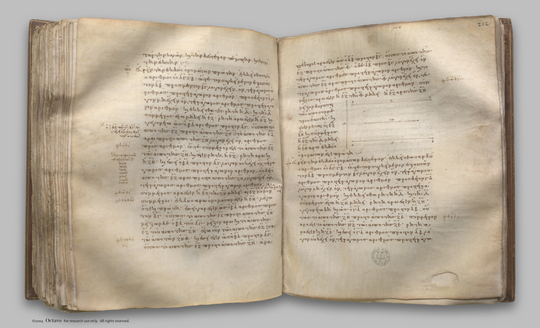index prev next | digilib folio 216

To find the second binomial straight line.
| Εὑρεῖν τὴν ἐκ δύο ὀνομάτων δευτέραν. Ἐκκείσθωσαν δύο ἀριθμοὶ οἱ ΑΓ, ΓΒ, ὥστε τὸν συγκείμενον ἐξ αὐτῶν τὸν ΑΒ πρὸς μὲν τὸν ΒΓ λόγον ἔχειν, ὃν τετράγωνος ἀριθμὸς πρὸς τετράγωνον ἀριθμόν, πρὸς δὲ τὸν ΑΓ λόγον μὴ ἔχειν, ὃν τετράγωνος ἀριθμὸς πρὸς τετράγωνον ἀριθμόν, καὶ ἐκκείσθω ῥητὴ ἡ Δ, καὶ τῇ Δ σύμμετρος ἔστω ἡ ΕΖ μήκει: ῥητὴ ἄρα ἐστὶν ἡ ΕΖ. γεγονέτω δὴ καὶ ὡς ὁ ΓΑ ἀριθμὸς πρὸς τὸν ΑΒ, οὕτως τὸ ἀπὸ τῆς ΕΖ πρὸς τὸ ἀπὸ τῆς ΖΗ: σύμμετρον ἄρα ἐστὶ τὸ ἀπὸ τῆς ΕΖ τῷ ἀπὸ τῆς ΖΗ. ῥητὴ ἄρα ἐστὶ καὶ ἡ ΖΗ. καὶ ἐπεὶ ὁ ΓΑ ἀριθμὸς πρὸς τὸν ΑΒ λόγον οὐκ ἔχει, ὃν τετράγωνος ἀριθμὸς πρὸς τετράγωνον ἀριθμόν, οὐδὲ τὸ ἀπὸ τῆς ΕΖ πρὸς τὸ ἀπὸ τῆς ΖΗ λόγον ἔχει, ὃν τετράγωνος ἀριθμὸς πρὸς τετράγωνον ἀριθμόν. ἀσύμμετρος ἄρα ἐστὶν ἡ ΕΖ τῇ ΖΗ μήκει: αἱ ΕΖ, ΖΗ ἄρα ῥηταί εἰσι δυνάμει μόνον σύμμετροι: ἐκ δύο ἄρα ὀνομάτων ἐστὶν ἡ ΕΗ. Δεικτέον δή, ὅτι καὶ δευτέρα. Ἐπεὶ γὰρ ἀνάπαλίν ἐστιν ὡς ὁ ΒΑ ἀριθμὸς πρὸς τὸν ΑΓ, οὕτως τὸ ἀπὸ τῆς ΗΖ πρὸς τὸ ἀπὸ τῆς ΖΕ, μείζων δὲ ὁ ΒΑ τοῦ ΑΓ, μεῖζον ἄρα [ καὶ ] τὸ ἀπὸ τῆς ΗΖ τοῦ ἀπὸ τῆς ΖΕ. ἔστω τῷ ἀπὸ τῆς ΗΖ ἴσα τὰ ἀπὸ τῶν ΕΖ, Θ: ἀναστρέψαντι ἄρα ἐστὶν ὡς ὁ ΑΒ πρὸς τὸν ΒΓ, οὕτως τὸ ἀπὸ τῆς ΖΗ πρὸς τὸ ἀπὸ τῆς Θ. ἀλλ' ὁ ΑΒ πρὸς τὸν ΒΓ λόγον ἔχει, ὃν τετράγωνος ἀριθμὸς πρὸς τετράγωνον ἀριθμόν: καὶ τὸ ἀπὸ τῆς ΖΗ ἄρα πρὸς τὸ ἀπὸ τῆς Θ λόγον ἔχει, ὃν τετράγωνος ἀριθμὸς πρὸς τετράγωνον ἀριθμόν. σύμμετρος ἄρα ἐστὶν ἡ ΖΗ τῇ Θ μήκει: ὥστε ἡ ΖΗ τῆς ΖΕ μεῖζον δύναται τῷ ἀπὸ συμμέτρου ἑαυτῇ. καί εἰσι ῥηταὶ αἱ ΖΗ, ΖΕ δυνάμει μόνον σύμμετροι, καὶ τὸ ΕΖ ἔλασσον ὄνομα τῇ ἐκκειμένῃ ῥητῇ σύμμετρόν ἐστι τῇ Δ μήκει. Ἡ ΕΗ ἄρα ἐκ δύο ὀνομάτων ἐστὶ δευτέρα: ὅπερ ἔδει δεῖξαι. | To find the second binomial straight line. Let two numbers AC, CB be set out such that the sum of them AB has to BC the ratio which a square number has to a square number, but has not to AC the ratio which a square number has to a square number; let a rational straight line D be set out, and let EF be commensurable in length with D; therefore EF is rational. Let it be contrived then that, as the number CA is to AB, so also is the square on EF to the square on FG; [X. 6, Por.] therefore the square on EF is commensurable with the square on FG. [X. 6] Therefore FG is also rational. Now, since the number CA has not to AB the ratio which a square number has to a square number, neither has the square on EF to the square on FG the ratio which a square number has to a square number. Therefore EF is incommensurable in length with FG; [X. 9] therefore EF, FG are rational straight lines commensurable in square only; therefore EG is binomial. [X. 36] It is next to be proved that it is also a second binomial straight line. For since, inversely, as the number BA is to AC, so is the square on GF to the square on FE, while BA is greater than AC, therefore the square on GF is greater than the square on FE. Let the squares on EF, H be equal to the square on GF; therefore, convertendo, as AB is to BC, so is the square on FG to the square on H. [V. 19, Por.] But AB has to BC the ratio which a square number has to a square number; therefore the square on FG also has to the square on H the ratio which a square number has to a square number. Therefore FG is commensurable in length with H; [X. 9] so that the square on FG is greater than the square on FE by the square on a straight line commensurable with FG. And FG, FE are rational straight lines commensurable in square only, and EF, the lesser term, is commensurable in length with the rational straight line D set out. |